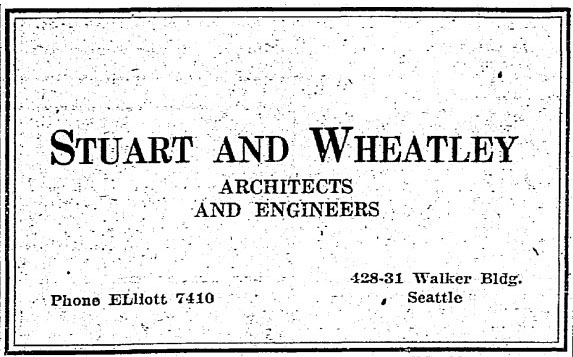Arthur Wheatley was born in England, in the industrial Yorkshire town of Barnsley on December 13, 1885. Details about his formal training and early career have not been discovered to date. Reportedly he practiced in Vancouver, British Columbia for a time, but this has not been verified. According to census records, Wheatley arrived in Seattle in 1916. From 1916 to 1923, he was in private practice, however projects attributed to him during this early part of his career are limited to the Beachmont Apartments (1920, 1519 e Madison St.); teh Holland Building (1920, 1415 4th Ave); two large homes in Laurelhurst (1922, addresses unknown); and the Woodland Park United Methodist Church (1923).
 When the firm formed in 1923, Arthur Wheatley formed a partnership with fellow brit Bertram D. Stewart and began to immediately receive commissions. The firm was highly active during the 1920s and they were particularly known for their well-designed, mid and high-rise apartment buildings (many with one bedroom or efficiency units, but elaborate lobbies). They favored the period revival styles popular at the time, and an examination of their work reveals a wide variety of styles from Beaux Arts and Flemish Revival, to Jacobethan Revival. One of their first projects was the six-story Biltmore Apartments (1924). With 125 apartments, it was described at the time as the largest apartment building in the Northwest, and was constructed at the reported cost of $750,000. Other notable apartment projects include the Stephensberg Apartments (1924); the Highlands Apartments (1924); Broadway Court (1925); Windsor Arms Apartments (1926); Sterling Court Apartments (1926); Levere Apartments (1928); Exeter House Apartments (1928); Shelby Apartments (1928); 715 24th Ave Apartments (1929); Talbott Apartments (1929, demolished); and the Charmaine Apartments (1929).
When the firm formed in 1923, Arthur Wheatley formed a partnership with fellow brit Bertram D. Stewart and began to immediately receive commissions. The firm was highly active during the 1920s and they were particularly known for their well-designed, mid and high-rise apartment buildings (many with one bedroom or efficiency units, but elaborate lobbies). They favored the period revival styles popular at the time, and an examination of their work reveals a wide variety of styles from Beaux Arts and Flemish Revival, to Jacobethan Revival. One of their first projects was the six-story Biltmore Apartments (1924). With 125 apartments, it was described at the time as the largest apartment building in the Northwest, and was constructed at the reported cost of $750,000. Other notable apartment projects include the Stephensberg Apartments (1924); the Highlands Apartments (1924); Broadway Court (1925); Windsor Arms Apartments (1926); Sterling Court Apartments (1926); Levere Apartments (1928); Exeter House Apartments (1928); Shelby Apartments (1928); 715 24th Ave Apartments (1929); Talbott Apartments (1929, demolished); and the Charmaine Apartments (1929).
While apartment projects were their main focus, they also designed three houses for University of Washington fraternal clubs, including the Chi Psi fraternity house (1927), the Sigma Alpha Epsilon fraternity house (1926), and the Chi Omega sorority house (1926). Stuart & Wheatley also designed several hotel buildings including the ten-story Hotel Claremont (1926); the Continental Hotel (1926); the twelve-story Bergonian Hotel (1926, now known as the Mayflower Park Hotel); and the Devonshire Hotel (1927, demolished) all in Seattle as well as the McGrath Cafe & Hotel in North Bend.
In 1931, with both partners now 46 years of age, they dissolved the firm and each went back to operating as sole proprietors, presumably to better weather the onset of the Depression years. Little information is available about Wheatley during the post firm years. Some reports note that he was employed by the city parks department from 1935 to 1940, however this has not been verified. Known work is limited to the Colman Playfield Shelter (1938); and a remodel of the Doris Apartments (1931, 715 6th Ave).
Newspaper accounts state that Wheatley suffered some type of medial trauma in 1940 after he was found huddled in a hollow stump a few miles from his home. By 1942 he was living in Sedro-Woolley at Northern State Hospital. He passed away in Seattle on May 6, 1946 at age 60 with little fanfare and is interned at the Forest Lawn Cemetery in west Seattle.





